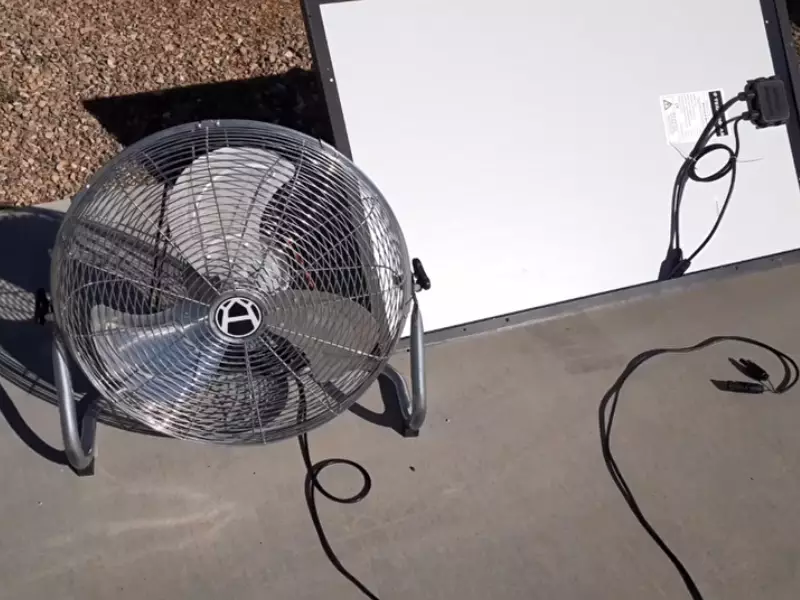The quest for cleaner and more efficient energy sources has prompted a significant shift towards renewable energy sources, with solar power leading the charge. This technology is revolutionizing how we power everything from homes and cars to small appliances. One such appliance that has seen considerable advancement is the fan, with solar power fans gaining increasing popularity due to their energy efficiency and eco-friendliness.
Harnessing solar energy to power a fan is both an innovative and practical solution, providing a consistent and reliable source of cool air while significantly reducing energy costs. The process entails using a solar panel to convert sunlight into electricity, which then powers the fan. This allows for a sustainable and efficient cooling system that can be used anywhere, be it indoors or outdoors.
As we progress into this post, you’ll gain a deeper understanding of solar power fans, how they work, and how to set up your own system. You’ll also learn about the benefits of this green technology and why it’s crucial to understand the risks of using DC with AC appliances. So, if you’re passionate about sustainability, cost savings, or simply a DIY enthusiast, this comprehensive guide is designed to provide all the information you need to successfully power a fan using a solar panel.
Understanding Different Types of Solar Fans
12v Solar Fan
A 12v solar fan operates using a 12-volt DC power, which comes directly from solar panels or a solar-charged battery. It is energy efficient and provides a significant amount of air movement. Perfect for ventilation in homes, RVs, or greenhouses, these fans are suitable for those seeking a reliable and sustainable cooling solution.
Solar Battery Fan
Solar battery fans are designed with an inbuilt battery that stores solar energy for later use. During the day, the solar panels charge the battery, ensuring the fan continues running even when the sun goes down. This type of fan is ideal for places where continuous cooling is needed, such as in homes or offices.

Solar Powered Outdoor Fan
These fans are designed for outdoor use and are commonly seen in patio umbrellas, greenhouses, or even camping sites. Solar powered outdoor fans run directly from the power harnessed from the sun, providing a comfortable, cool environment in outdoor settings where access to electricity might be a challenge.
Solar Electric Fans
Solar electric fans convert solar energy into electricity, which powers the fan. They can either run directly off the solar panels during the day or use batteries to store power for later use. These fans are incredibly efficient and can significantly reduce your reliance on grid power.
Portable Solar Fans
Portable solar fans are compact, lightweight, and are designed for easy transportation and installation. They run on solar power, either directly from a solar panel or from a charged battery. They’re perfect for camping trips, outdoor events, or even for emergency power outages.
The Nuts and Bolts of Solar Fans
At its core, a solar fan operates using the energy from the sun. Solar panels convert solar energy into electricity, either directly powering the fan or charging a battery for later use. It’s important to note that while it’s possible to run a fan directly from a solar panel, it may not always be the most efficient method. The amount of sunlight, the power of the solar panel, and the energy requirements of the fan all play a part in determining the most suitable setup for your needs.
Connecting Solar Panel to a Fan: Step by Step
Essential Components Needed
To set up a solar-powered fan, you’ll need a few key components: a solar panel, a charge controller, a battery, an inverter (for AC fans), and of course, the fan itself.
Steps to Connect a Solar Panel to a Fan
- Connect the Solar Panel to the Charge Controller: This controller regulates the voltage and current coming from the solar panels and prevents the battery from overcharging.
- Connect the Charge Controller to the Battery: The energy generated from the solar panels is stored in the battery, ensuring power availability even when the sun is not shining.
- Connect the Battery to the Inverter (if using AC fan): Inverters convert DC power from the solar panel or battery to AC power, which is used by most household appliances.
- Connect the Inverter or Battery to the Fan: Finally, connect your fan to the power source. If it’s a DC fan, you can connect it directly to the battery. If it’s an AC fan, connect it to the inverter.
Can I Run a 12V Fan on a Solar Panel?
Yes, you can. A 12V DC fan can be directly connected to a solar panel. However, to ensure that the fan continues to operate when there is no sunlight, it’s advised to use a solar panel to charge a 12V battery, which then powers the fan.

Energy Output: What Will Solar Panels Charge?
Solar panels generate electricity based on the amount of sunlight they receive. Typically, a standard solar panel will generate around 200 to 400 watts of power. However, the actual power output can vary depending on factors like the size of the solar panel, the intensity and angle of sunlight, and the efficiency of the solar cells.
So, how many solar panels does it take to run a fan? The answer depends on the power consumption of your fan. For instance, a standard desk fan uses about 10 to 25 watts of power. Therefore, even a small solar panel should be sufficient to run a single fan. If you plan to run multiple fans or other appliances, you’ll need more solar panels or a larger capacity solar panel.
Risks of Using DC with AC Appliances
Direct Current (DC) and Alternating Current (AC) are two different types of electrical current. Solar panels produce DC, which can be used directly by DC appliances or converted to AC by an inverter for AC appliances. However, using DC with AC appliances without an appropriate inverter can lead to several issues:
- Damage to the Appliance: AC appliances are not designed to handle DC input, which could lead to overheating and damage.
- Inefficiency: Without proper conversion, the appliance may not work efficiently, leading to higher power consumption or poor performance.
- Safety Risks: Incorrectly mixing DC and AC can lead to electrical shocks or even fires. Always use a suitable inverter when connecting DC power sources to AC appliances.
Benefits of Solar-Powered Fans for Home
Solar-powered fans offer numerous benefits that make them an excellent choice for cooling your home:
- Energy Efficiency: Solar fans use the renewable energy of the sun, reducing reliance on traditional electricity and cutting down energy bills.
- Cost Savings: Apart from energy cost savings, solar fans require minimal maintenance, further saving on upkeep costs.
- Eco-friendly: Solar fans contribute to reducing carbon footprint as they don’t rely on fossil fuels, making them an environmentally friendly choice.
- Versatility: Whether it’s for your living room, your greenhouse, or your outdoor camping trip, there is a solar fan designed to meet your needs.
Frequently Asked Questions (FAQs)
Can a solar fan work at night?
Yes, if the solar fan is connected to a battery that stores power, it can continue to operate during the night or in cloudy conditions. However, if the fan runs directly from a solar panel without a storage system, it will not work without sunlight.
Is it expensive to set up a solar-powered fan system?
The initial cost can be relatively high due to the price of solar panels and associated equipment. However, the long-term savings on energy bills and the longevity of solar panels make it a cost-effective solution in the long run.
Can I use my existing fan, or do I need a specific solar fan?
While there are fans designed specifically for solar power, you can also use a standard AC or DC fan. However, remember that for an AC fan, you will need an inverter to convert the DC power from the solar panel into AC.
Conclusion
Solar power fans are an innovative, eco-friendly, and cost-effective solution to cooling needs, be it for your home, your outdoor area, or even a portable option for your adventures. With a basic understanding of solar power and the right components, you can set up your solar fan system.
However, remember that like any electrical system, it’s crucial to install and use it correctly. Always understand the risks associated with using DC with AC appliances and take the necessary precautions.
With the information provided in this comprehensive guide, you’re now equipped to embark on your journey towards a more sustainable, energy-efficient future with solar power fans.
Remember, every step towards renewable energy not only contributes to financial savings but also to a healthier planet for future generations. So go ahead, harness the power of the sun, and keep cool with your new solar-powered fan!
